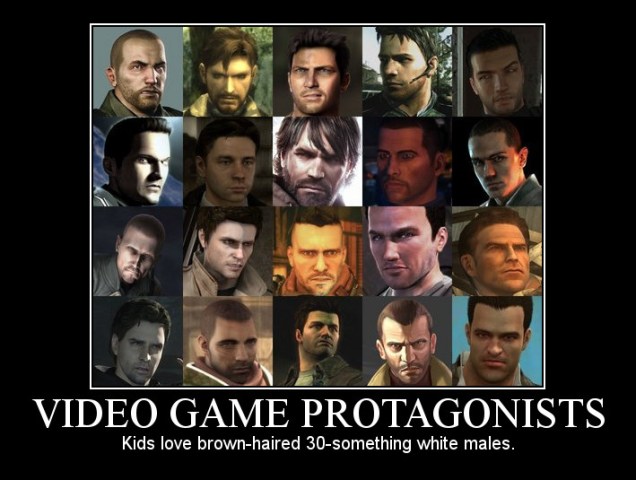New Study Explores Representation in Gaming and Surprise! There Are a Lot of White Dudes
I'm a dude, he's a dude, she's a dude, we're all dudes!

Today in “stuff we already know because we have eyeballs,” a new study by a recent graduate of Ithaca College took a look at 50 highly-rated games to map the racial and gender representation of video game characters. You can probably guess what conclusion he came to—a whole heaping bunch of hyper-aggressive, white male protagonists.
Ross Orlando, a sociology major and Africa diaspora minor with an intense interest in video games, recently presented a paper entitled “Race and Gender: A Look at Modern Video Games” during the James J. Whalen Academic Symposium this spring. He analyzed ten of the highest rated games for each year from 2007 to 2012, including Journey, Mass Effect 3, Metal Gear Solid 4, Dark Souls, Red Dead Redemption, Call of Duty: Black Ops, and more. Of the 61 protagonists (not counting the ones that have customizable genders, of course), 45 were designated male and only five were female. Of those five female protagonists, only two were the leads of their games.
Racial diversity, he found, was also lacking: white people make up 67% of characters, whereas black and Asian people make up only 3%, Latino people are only 1%, and Indigeneous people don’t appear at all. Although it’s not all bad news, because he notes that, “There were little signs of blatant racial stereotypes present outside of racism by omission.” So at the very, very least, game makers aren’t being intentionally offensive with the one black guy they drop into their games every couple of years or so. Small victories, or whatever.
Orlando also noted that 75% of the Japanese-developed games on his list feature white protagonists as well. He suggests that this is because the majority of these games are meant to cross over into North American and European markets, as Japan has its own insular gaming industry that prominently deals with Japanese characters. Presumably, he also took into account the false assumption on the part of Western audiences that all anime characters are supposed to read as white, as there are several games on that list that utilize such a style, but it’s worth mentioning that particular fallacy anyway, because it’s annoying as heck.
And what are all these characters like? Aggressive, mostly—45% of the 45 male characters exhibited very stereotypical masculine qualities, and 15% of all characters (both male and female) were hyper-sexualized as well. Fun!
While Orlando will be the first one to tell you that his study is pretty shallow in depth and says a lot of things that even the most casual gamers already know, he hopes that continuing to analyze games for diversity will make future developers and consumers think critically about the medium they’re supporting. After all, racial and gender diversity doesn’t just strengthen communities and inspire marginalized people—it also keeps all the games from literally looking exactly the same as each other. Or are we not just a little bored of brown-haired white guys already?
The full list of games that Orlando analyzed can be found here.
(via Phys.org, image via Cracked)
- Luigi is judging you for your lack of representation
- Did anyone really expect Obama to play The Witcher 2?
- Candy Crush Saga is sort of the worst
Have a tip we should know? [email protected]